外研七下学案( Module8 Unit3)
外研版七年级英语下册教案:Module8Unit3Languageinuse
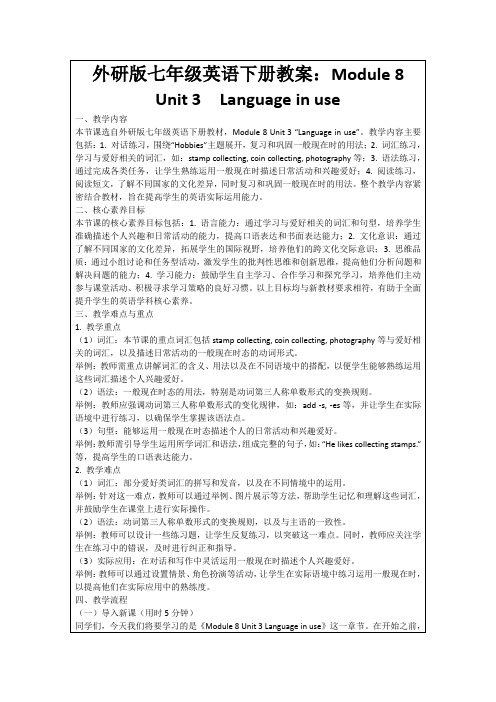
本节课的核心素养目标包括:1.语言能力:通过学习与爱好相关的词汇和句型,培养学生准确描述个人兴趣和日常活动的能力,提高口语表达和书面表达能力;2.文化意识:通过了解不同国家的文化差异,拓展学生的国际视野,培养他们的跨文化交际意识;3.思维品质:通过小组讨论和任务型活动,激发学生的批判性思维和创新思维,提高他们分析问题和解决问题的能力;4.学习能力:鼓励学生自主学习、合作学习和探究学习,培养他们主动参与课堂活动、积极寻求学习策略的良好习惯。以上目标均与新教材要求相符,有助于全面提升学生的英语学科核心素养。
(五)总结回顾(用时5分钟)
今天的学习,我们了解了如何用一般现在时谈论兴趣爱好,以及相关的词汇和语法点。通过实践活动和小组讨论,我们加深了对这一知识点的理解。我希望大家能够掌握这些知识点,并在日常生活中灵活运用。最后,如果有任何疑问或不明白的地方,请随时向我提问。
五、教学反思
在今天的教学中,我发现学生们对一般现在时态的运用以及兴趣爱好类词汇的学习表现出较大的兴趣。他们在小组讨论和对话练习中积极参与,课堂氛围活跃。然而,我也注意到一些问题需要我在今后的教学中加以改进。
外研版七年级英语下册教案:Module 8 Unit 3 Language in use
一、教学内容
本节课选自外研版七年级英语下册教材,Module 8 Unit 3 “Language in use”。教学内容主要包括:1.对话练习,围绕“Hobbies”主题展开,复习和巩固一般现在时的用法;2.词汇练习,学习与爱好相关的词汇,如:stamp collecting, coin collecting, photography等;3.语法练习,通过完成各类任务,让学生熟练运用一般现在时描述日常活动和兴趣爱好;4.阅读练习,阅读短文,了解不同国家的文化差异,同时复习和巩固一般现在时的用法。整个教学内容紧密结合教材,旨在提高学生的英语实际运用能力。
七年级英语Module8Unit3教案外研社
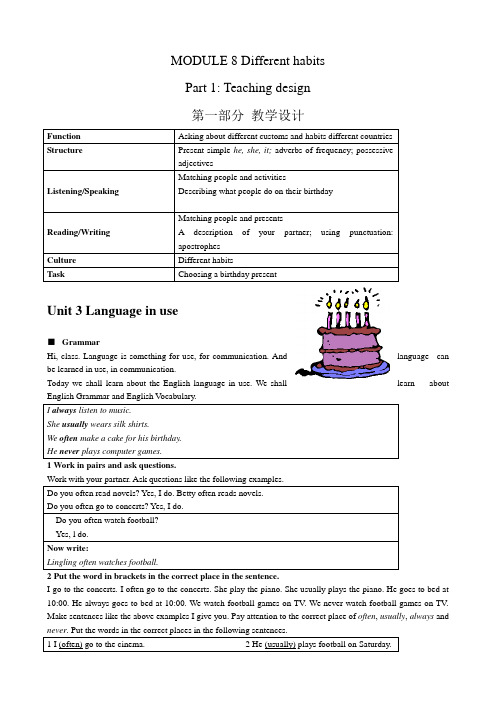
MODULE 8 Different habitsPart 1: Teaching design第一部分教学设计Function Asking about different customs and habits different countries Structure Present simple he, she, it; adverbs of frequency; possessiveadjectivesListening/Speaking Matching people and activities Describing what people do on their birthdayReading/Writing Matching people and presentsA description of your partner; using punctuation: apostrophesCulture Different habitsTask Choosing a birthday presentUnit 3 Language in use■GrammarHi, class. Language is something for use, for communication. And language can be learned in use, in communication.Today we shall learn about the English language in use. We shall learn aboutI always listen to music.She usually wears silk shirts.We often make a cake for his birthday.He never plays computer games.1 Work in pairs and ask questions.Do you often read novels? Yes, I do. Betty often reads novels.Do you often go to concerts? Yes, I do.---Do you often watch football?---Yes, l do.Now write:Lingling often watches football.2 Put the word in brackets in the correct place in the sentence.I go to the concerts. I often go to the concerts. She play the piano. She usually plays the piano. He goes to bed at 10:00. He always goes to bed at 10:00. We watch football games on TV. We never watch football games on TV. Make sentences like the above examples I give you. Pay attention to the correct place of often, usually, always and1 I (often) go to the cinema.2 He (usually) plays football on Saturday.3 Match the words in Column 1 with the words in Column 2.I am a student. This is my book. You are a doctor. This is your hospital. He is a teacher. I am his student. She is my mother. I am her daughter. What’s it in their classroom? It is a TV. Its colour is black. We are having our dinner now. Do you know how to use the following words now? Match the words in Column 1 with the words in4 Complete the sentences.I like Tom Hanks. He’s my favourite actor. She likes Gone with the wind. It’s her favourite film. We often listen to music. There are a lot of CDs in my home. Let’s buy a present for Betty. It’s her birthday. Tony’s grandparents live in the UK. Their home is in London. Hello, what’s your favourite film star? Complete the sentences below. Use■Vocabulary5 Write words that go with:Use your imagination and try to write as many words as possible. For example, bananas, noodles, dumplings,■Around the worldWhat do people give as birthday presents in the UK and the USA? Do they often open their presents at once?■Module task →Choosing a birthday present6 Think of someone in your family. Write a description of him / her.Hi, class! I would like you to think of someone in your family and write a description of him or her. What does he or she like? What does he or she always do? What does he or she usually do? What does he or she never do? Write7 Work in pairs. Show your description to your partner. Choose a birthday present.Work with your partner. Please show your description to your partner. What do you think of each other’s description? What can you learn from each other’s description? Choose a birthday present for the person you write. Will he or she like your present? Does your present suit him or her?。
外研版英语七年级下册Module8Unit3《Languageinuse》说课稿

外研版英语七年级下册Module 8 Unit 3《Language in use》说课稿一. 教材分析外研版英语七年级下册Module 8 Unit 3《Language in use》的主题是关于日常生活中的交际用语。
通过本节课的学习,学生将掌握一些基本的交际用语,如问候、介绍、道别等,并能够运用所学知识进行简单的实际交流。
教材内容丰富,贴近学生的生活实际,有利于激发学生的学习兴趣和积极性。
二. 学情分析七年级的学生已经具备了一定的英语基础,对于日常生活中的基本交际用语有一定的了解。
但是,学生在实际运用英语进行交流时,往往会因为词汇量不足、语法不扎实等原因感到困难。
因此,在教学过程中,需要注重学生的语言实践,提高他们的口语表达能力。
三. 说教学目标1.知识目标:学生能够掌握本节课所学的交际用语,并能够正确运用。
2.能力目标:学生能够通过pr work、group work等形式,进行简单的英语交流,提高口语表达能力。
3.情感目标:培养学生对英语学习的兴趣,增强自信心,培养合作精神。
四. 说教学重难点1.重点:学生能够掌握并正确运用本节课所学的交际用语。
2.难点:学生能够在实际交流中,灵活运用所学知识,进行流畅的英语表达。
五. 说教学方法与手段1.交际法:通过模拟真实场景,让学生在实际交流中运用所学知识,提高口语表达能力。
2.任务型教学法:通过完成各种任务,激发学生的学习兴趣,培养学生的合作精神。
3.多媒体教学手段:利用多媒体课件,生动展示教学内容,提高学生的学习积极性。
六. 说教学过程1.导入:通过与学生谈论日常生活中的交际情景,引出本节课的主题。
2.呈现:展示本节课所学的交际用语,让学生整体感知。
3.操练:通过pr work、group work等形式,让学生在实际交流中运用所学知识。
4.巩固:通过各种游戏、活动,让学生在轻松愉快的氛围中巩固所学知识。
5.拓展:引导学生运用所学知识,进行实际生活中的交际情景模拟。
新外研版七年级下册英语 Module 8 Unit 3 教案(教学设计)
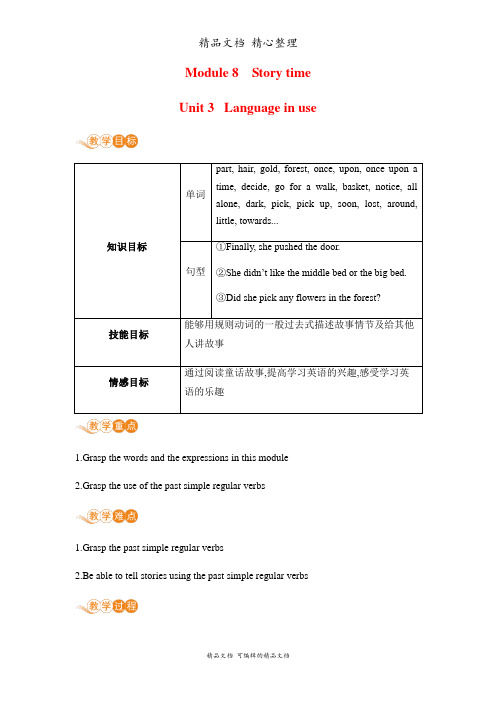
Module 8Story time Unit 3 Language in usepart, hair, gold, forest, once, upon, once upon a1.Grasp the words and the expressions in this module2.Grasp the use of the past simple regular verbs1.Grasp the past simple regular verbs2.Be able to tell stories using the past simple regular verbsModule task Let students work in pairs. Look at the pictures and make e the words given.教师活动Module task 【参考答案】The father loved the little girl.The father and the little girl played games in the garden.The little girl fell off the boat and died in the sea.She changed into a bird called Jingwei.Her father watched the bird and was unhappy.The bird decided to fill up the sea with the stones.教师活动Write a story and then read your writing to your friends.本节课的教学活动设计,能够创设丰富的语境,设置循序渐进的学习任务,充分发挥学生的主体作用,引导学生合作学习、自主探究,重视“预习—展示—练习—反馈”的学习过程。
外研版英语七年级下册Module 8 Story time Unit 3教案

Module8Story timeUnit3Language in use本模块以童话故事为题材,用故事贯穿模块,要求学生读懂故事,并能用一般过去时讲一个完整的故事。
本模块的主要语法是规则动词的过去式,教学重点是在童话故事中学习规则动词的过去式,以及本模块中出现的重点词汇、短语、固定搭配和句型。
本单元是一节复习应用课,.这一单元的活动和任务都是围绕着童话故事设计的.通过阅读童话故事激发学生的阅读欲望,使他们爱上阅读,并在阅读过程中掌握规则动词的过去式且会用一般过去时来讲述童话故事。
巩固u1 和u2 中出现的重点词汇与短语1)能听懂简单故事中的主要人物和事件。
2)能用一些规则动词的过去式描述过去的事情或讲一个故事。
3) 能够读懂简单的故事,明白其中的人物关系,并能就故事作答。
而且,掌握短文通篇大意,学习使用上下文猜测词义的学习方法。
4)能用规则动词的过去式叙述简单的事情或故事。
3 、巩固前两个单元的重点词汇和短语,能够学会用一般过去时讲述故事以及过去发生的事情。
能尝试阅读一些简单的英文童话故事;注意从他人的演示中汲取知识。
以说为主要教学方式,以讨论为主要方法,通过同桌讨论和小组以及全班讨论,让每个学生充分练习口语和说的能力,并将听说读写有机地贯穿一体。
设立一些语言环境,结合童话故事《金凤花姑娘和三只熊》,最后一起学习本模块的重、难点,为突破重、难点再做一些课堂和课后的练习。
教材、教学多媒体课件、手绘故事图片、绳子和夹子。
Step1.Warming-up通过rap 的形式导入新课“ Story,story,everywhere.Children like them so much.We all like stories,I like stories ,too.”。
T :Do you like stories?白板展示《金凤花姑娘和三只小熊》的故事图片,让学生根据所给动词提示用一句话来描述图片内容。
通过Rap 和图片导入本课内容,激发学生的学习兴趣,通过描述图片回顾行为动词过去式的形式和用法。
英语七下外研版Module8Unit3教案【精品】
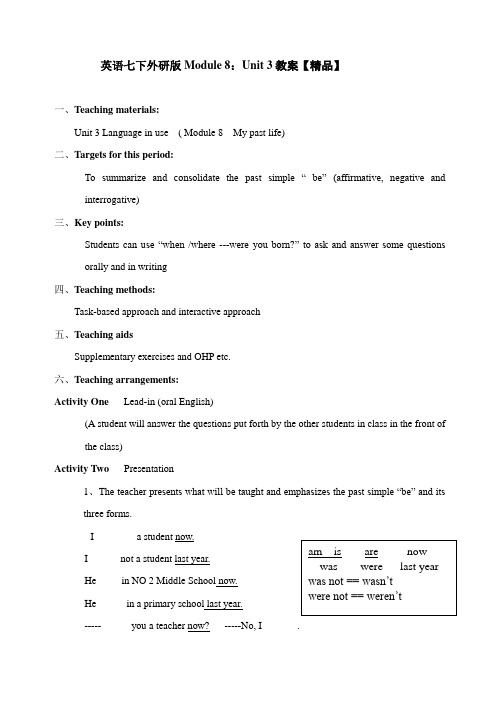
英语七下外研版Module 8:Unit 3教案【精品】一、Teaching materials:Unit 3 Language in use ( Module 8 My past life)二、Targets for this period:To summarize and consolidate the past simple “ be” (affirmative, negative and interrogative)三、Key points:Students can u se “when /where ---were you born?” to ask and answer some questions orally and in writing四、Teaching methods:Task-based approach and interactive approach五、Teaching aidsSupplementary exercises and OHP etc.六、Teaching arrangements:Activity One Lead-in (oral English)(A student will answer the questions put forth by the other students in class in the front ofthe class)Activity Two Presentation1、The teacher presents what will be taught and emphasizes the past simple “be” and itsthree forms.I________ a student now.He ____ in NO 2 Middle School now.He _____ in a primary school last year.----- _____ you a teacher now? -----No, I ______ .----- _____ you not a teacher last year? ----- Yes, I ______.2、Do some supplementary exercises.Activity Three Ask and answer the questions(suppose you were Liu Yun. Ask and answer the questions with the given words) when / bornwhat / primary schoolwho / first teacherwho / first friendwhat / likeActivity Four Stude nts’ surveysActivity Five Complete the sentences according to the ChineseActivity Six Write about your past lifeActivity Seven SummaryBlackboard designingUnit 3 Language in use1、I was born in a small village.2、Tony wasn’t born in China.3、Who were your first friends?4、She was strict.5、Were they naughty? Yes, they were. / No, they weren’t.Homework for you : EX 4 to 5WB p116。
外研版英语七年级下册:Module 8 Unit 3 Language in use. 复习导学案设
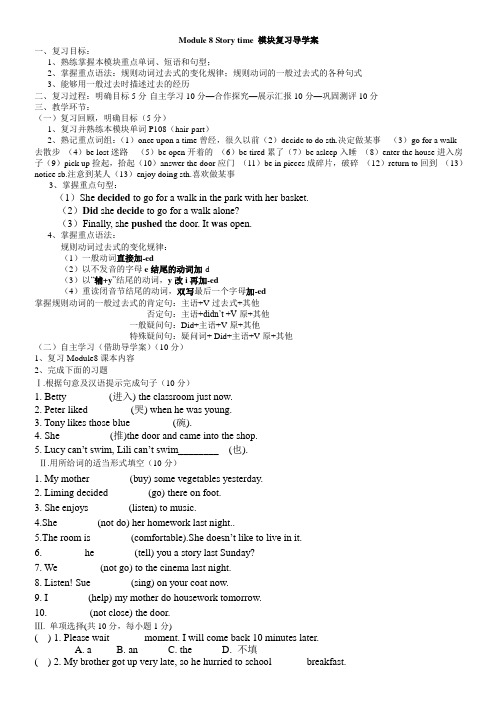
Module 8 Story time 模块复习导学案一、复习目标:1、熟练掌握本模块重点单词、短语和句型;2、掌握重点语法:规则动词过去式的变化规律;规则动词的一般过去式的各种句式3、能够用一般过去时描述过去的经历二、复习过程:明确目标5分-自主学习10分—合作探究—展示汇报10分—巩固测评10分三、教学环节:(一)复习回顾,明确目标(5分)1、复习并熟练本模块单词P108(hair-part)2、熟记重点词组:(1)once upon a time曾经,很久以前(2)decide to do sth.决定做某事(3)go for a walk去散步(4)be lost迷路(5)be open开着的(6)be tired累了(7)be asleep入睡(8)enter the house进入房子(9)pick up捡起,拾起(10)answer the door应门(11)be in pieces成碎片,破碎(12)return to回到(13)notice sb.注意到某人(13)enjoy doing sth.喜欢做某事3、掌握重点句型:(1)She decided to go for a walk in the park with her basket.(2)Did she decide to go for a walk alone?(3)Finally, she pushed the door. It was open.4、掌握重点语法:规则动词过去式的变化规律:(1)一般动词直接加-ed(2)以不发音的字母e结尾的动词加-d(3)以“辅+y”结尾的动词,y改i再加-ed(4)重读闭音节结尾的动词,双写最后一个字母加-ed掌握规则动词的一般过去式的肯定句:主语+V过去式+其他否定句:主语+didn’t +V原+其他一般疑问句:Did+主语+V原+其他特殊疑问句:疑问词+ Did+主语+V原+其他(二)自主学习(借助导学案)(10分)1、复习Module8课本内容2、完成下面的习题Ⅰ.根据句意及汉语提示完成句子(10分)1. Betty ________(进入) the classroom just now.2. Peter liked ________(哭) when he was young.3. Tony likes those blue ________(碗).4. She__________(推)the door and came into the shop.5. Lucy can’t swim, Lili can’t swim__________(也).Ⅱ.用所给词的适当形式填空(10分)1. My mother________(buy) some vegetables yesterday.2. Liming decided________(go) there on foot.3. She enjoys________(listen) to music.4.She________(not do) her homework last night..5.The room is________(comfortable).Sh e doesn’t like to live in it.6. ________he________(tell) you a story last Sunday?7. We ________(not go) to the cinema last night.8. Listen! Sue________(sing) on your coat now.9. I________(help) my mother do housework tomorrow.10. ________(not close) the door.Ⅲ. 单项选择(共10分,每小题1分)( ) 1. Please wait ______ moment. I will come back 10 minutes later.A. aB. anC. theD. 不填( ) 2. My brother got up very late, so he hurried to school ______ breakfast.A. forB. pastC. withoutD. by( ) 3. My little dog didn’t ______ home last night.A. returnB. return backC. returnedD. returned back( ) 4. Hello, Miss Wang. Can you ______ us a story?A. sayB. tellC. speakD. talk( ) 5. Wang Bing noticed his son ______ to music just now.A. listensB. listeningC. to listenD. listened( ) 6. John was sad because his cup was ______.A. in piecesB. on piecesC. on pieceD. in piece( ) 7. There are two books there. Please ______.A. pick to themB. pick up themC. pick them toD. pick them up( ) 8. My mother decided ______ the work before ten o’clock.A. finishB. finishesC. finishedD. to finish( ) 9. ______, Mike’s father was a teacher. Later, he worked as a driver.A. At the momentB. NextC. At firstD. Finally( ) 10. Bill ______ his homework yesterday.A. won’t doB. isn’t doingC. didn’t doD. doesn’t do三、合作探究1.对子互学:交流自学时遇到的问题,互教互学。
外研版英语七年级下册:Module 8 Unit 3 Language in use. 课程教学设计

教学设计外语教学与研究出版社《新标准》英语初中一年级下册Module Eight Story timeUnit Three Language in use一、教材分析本模块以童话故事为话题,通过阅读童话故事激发学生的阅读欲望,让学生在阅读童话、学习英语的同时,体会童话的精神美、形态美、语言美,促进学生人格的培养。
本单元为复习单元,学生在前两个单元的感受和体验之后,在本课,通过教师的引导,对本模块的重点知识,包括动词的过去式及其规则变化,讲故事的时候连词的灵活使用等进行梳理、归纳和总结,并利用故事,在创设的语境中帮助学生熟练和准确地使用。
在本模块学习结束后,能够讲述自己喜欢的故事以及描述自己做过的事情。
二、教学目标1.知识目标(1) To summarise and consolidate the new vocabulary and some past simple regular verbs(2) Consolidate the usage of “and, but, because, so, first, next, and then, finally” in telling a story(3) Past simple tense (肯定句,否定句,一般疑问句及回答)2.技能目标(1) Tell a story with past simple regular verbs(2) Talk about something did with past simple regular verbs3.学习策略目标(1) 采用问题化教学模式引导学生对知识总结归纳(2)通过小组合作的方式,学会合作学习;4.情感与态度目标在教学过程中,学生们通过实践、参与有意义的各种形式的活动,体验与他人合作,共同完成学习任务的乐趣。
在本课中,通过对童话故事的阅读,培养阅读的乐趣。
5.教学重点和难点学会准确使用动词过去式的规则变化来讲故事。
外研版英语七年级下Module8 Unit3教案

Unit 3 Language in useTeaching aims:1. Review the useful words and expressions of this Module.2. To summarise and consolidate past simple regular verbs.Teaching points:1. Grammar: The simple past tense.2. The useful sentences: She didn’t like the food in the big bowl.They didn’t notice Goldilocks at first.Teaching procedures:Language practice:Let the students read through the example sentences. Let the students understand the regular past simple works in all three forms.Step 1. Complete the sentence with the correct form of the words in box.Ask the students to do the exercises and then check with a partner.Collect the answers from the class.Answers:1. pointed2. entered3. jumped4. hurried5. answer6. return7. like8. triedStep 2. Complete the passage with the correct form of the words in the boxLet the students do the exercises by themselves and then check with a partner.Ask some students to say their answers.Answers:1. wanted2. walked3. picked4. noticed5. knocked6. answered7. entered 8. were 9. looked 10. askedAround the world:Ask the students to look at the picture and tell us what they can see.Let some students tell the story Snow White.Module task: Telling a storyStep 3. Work in pairs. Look at the pictures and make sentences using the words given.Ask the students to look at the pictures in pairs and decide what parts of the story theyshow.Ask the students to use the words to write sentences about the pictures.Step 4. Put the sentences together to make a story. Remember to use words like and, so, but, because, first, next, and then and finally.Ask the students to write with a partner, making sure they check their passage carefully for errors.Step 5. Do some exercises一、根据句意和首字母填入合适的单词。
外研版英语七年级下册:Module 8 Unit 3 Language in use. 教学设计
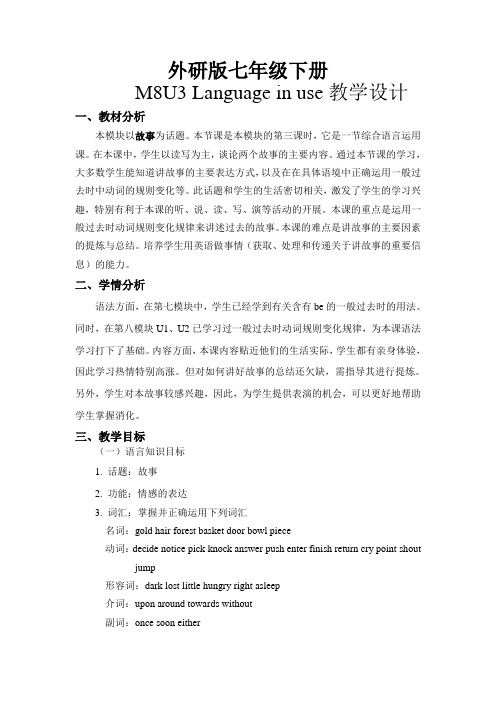
外研版七年级下册M8U3 Language in use教学设计一、教材分析本模块以故事为话题。
本节课是本模块的第三课时,它是一节综合语言运用课。
在本课中,学生以读写为主,谈论两个故事的主要内容。
通过本节课的学习,大多数学生能知道讲故事的主要表达方式,以及在在具体语境中正确运用一般过去时中动词的规则变化等。
此话题和学生的生活密切相关,激发了学生的学习兴趣,特别有利于本课的听、说、读、写、演等活动的开展。
本课的重点是运用一般过去时动词规则变化规律来讲述过去的故事。
本课的难点是讲故事的主要因素的提炼与总结。
培养学生用英语做事情(获取、处理和传递关于讲故事的重要信息)的能力。
二、学情分析语法方面,在第七模块中,学生已经学到有关含有be的一般过去时的用法。
同时,在第八模块U1、U2已学习过一般过去时动词规则变化规律,为本课语法学习打下了基础。
内容方面,本课内容贴近他们的生活实际,学生都有亲身体验,因此学习热情特别高涨。
但对如何讲好故事的总结还欠缺,需指导其进行提炼。
另外,学生对本故事较感兴趣,因此,为学生提供表演的机会,可以更好地帮助学生掌握消化。
三、教学目标(一)语言知识目标1. 话题:故事2. 功能:情感的表达3. 词汇:掌握并正确运用下列词汇名词:gold hair forest basket door bowl piece动词:decide notice pick knock answer push enter finish return cry point shout jump形容词:dark lost little hungry right asleep介词:upon around towards without副词:once soon either重点词组:once upon a time go for a walk all alone pick up in pieces at first point at4. 语法:一般过去时动词规则变化的用法(二)技能目标1. 能运用一般过去时讲述故事;2. 能仿照本课的重点内容并完成看图讲故事。
外研版七年级下册英语精品教案 Module 8 Unit 3 教案
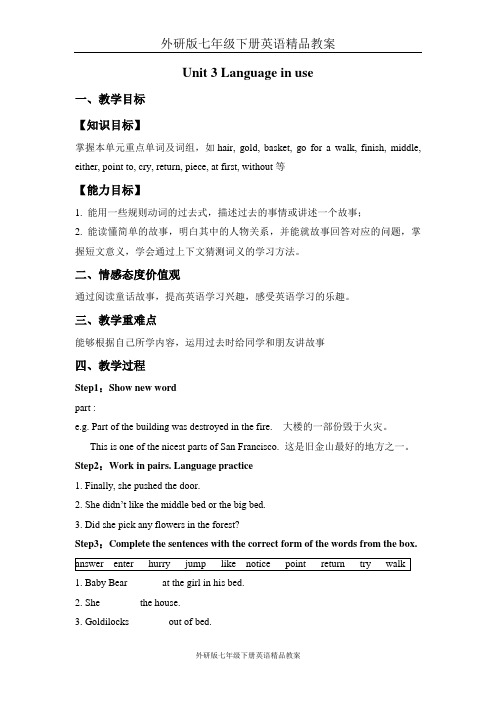
Unit 3 Language in use一、教学目标【知识目标】掌握本单元重点单词及词组,如hair, gold, basket, go for a walk, finish, middle, either, point to, cry, return, piece, at first, without等【能力目标】1. 能用一些规则动词的过去式,描述过去的事情或讲述一个故事;2. 能读懂简单的故事,明白其中的人物关系,并能就故事回答对应的问题,掌握短文意义,学会通过上下文猜测词义的学习方法。
二、情感态度价值观通过阅读童话故事,提高英语学习兴趣,感受英语学习的乐趣。
三、教学重难点能够根据自己所学内容,运用过去时给同学和朋友讲故事四、教学过程Step1:Show new wordpart :e.g. Part of the building was destroyed in the fire. 大楼的一部份毁于火灾。
This is one of the nicest parts of San Francisco.这是旧金山最好的地方之一。
Step2:Work in pairs. Language practice1. Finally, she pushed the door.2. She didn’t like the middle bed or the big bed.3. Did she pick any flowers in the forest?Step3:Complete the sentences with the correct form of the words from the box.1. Baby Bear ______ at the girl in his bed.2. She _______ the house.3. Goldilocks _______ out of bed.4. She _______ to the little house.5. The Three Bears didn’t _____ the door because they were out in the forest.6. The Three Bears didn’t __________ Goldilocks in bed at first.7. Goldilocks didn’t _____ to that part of the forest again.8. —Did she _____ the small chair first?—No, she didn’t. She tried the big chair first.9. —Did she _____ the small bed?—Yes, she did.Step4:Complete the passage of Activity 2 with the correct form of the words from the box.Now work in pairs. Ask and answer the questions.1. Did Tom want to go for a walk in the dark forest? Yes, he did.2. Did he pick a lot of blue flowers? No, he didn’t.3. Did he notice a house? Yes, he did.4. Did he knock on the door first? Yes, he did.Step5:Around the world—— To know Fairy talesStep6:Module task——Telling a storyWork in pairs. Look at the pictures of Activity 3 and make sentences. Use the words given.Step7:Put the sentences together to make a story. Remember to use words like “and”, “so”, “but”, “because”, “first”, “next”, “and then” and “finally”.Once upon a time there was a little girl called Nüwa. Her father was Emperor Yan and he loved ……Step8:Read your story to another pair and listen to theirs.Step9: Language points1. dark ~~ brighte.g. 1) This room is dark but that one is bright.2) The day is bright and the night is dark.2. little ~~ big / largee.g. 1) My schoolbag is little but his is big.2 ) My cup is little but my father’s is big.3) The hill is little but the mountain is large.3. the usage of the word “right”4. hungry ~~ thirstye.g. 1) The little boy is hungry and he wants to eat.2) She is thirsty and she wants to drink.Step10:Study Grammar ——The simple past tense上个模块中,我们学习了be 动词的过去式,那么一般动词的过去式是如何构成呢?请同学们观察下面的例句:Jack often goes to school by bike, but today he walked to school.杰克经常骑自行车去学校,但是今天他是走路去的学校。
外研版英语七年级下册Module8 Unit3参考学案
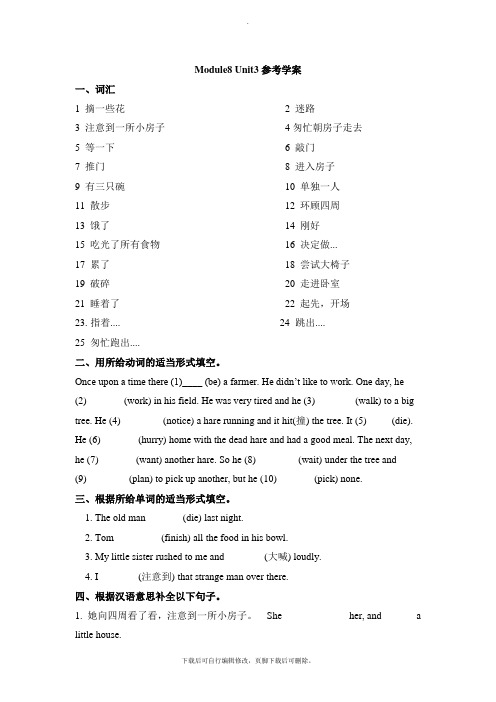
Module8 Unit3参考学案一、词汇1 摘一些花2 迷路3 注意到一所小房子4匆忙朝房子走去5 等一下6 敲门7 推门8 进入房子9 有三只碗10 单独一人11 散步12 环顾四周13 饿了14 刚好15 吃光了所有食物16 决定做...17 累了18 尝试大椅子19 破碎20 走进卧室21 睡着了22 起先,开场23.指着.... 24 跳出....25 匆忙跑出....二、用所给动词的适当形式填空。
Once upon a time there (1)____ (be) a farmer. He didn’t like to work. One day, he (2)_______ (work) in his field. He was very tired and he (3)________(walk) to a big tree. He (4)________ (notice) a hare running and it hit(撞) the tree. It (5) ____ (die). He (6)_______ (hurry) home with the dead hare and had a good meal. The next day, he (7)_______ (want) another hare. So he (8)________ (wait) under the tree and(9)________ (plan) to pick up another, but he (10)_______ (pick) none.三、根据所给单词的适当形式填空。
1. The old man ____ (die) last night.2. Tom _______ (finish) all the food in his bowl.3. My little sister rushed to me and _______ (大喊) loudly.4. I _______ (注意到) that strange man over there.四、根据汉语意思补全以下句子。
外研版英语七年级下册Module8导学案Unit3
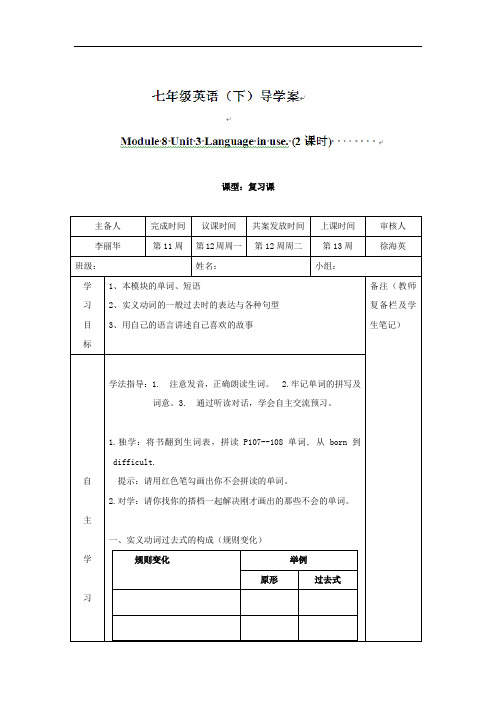
课型:复习课主备人完成时间议课时间共案发放时间上课时间审核人李丽华第11周第12周周一第12周周二第13周徐海英班级:姓名:小组:学习目标1、本模块的单词、短语2、实义动词的一般过去时的表达与各种句型3、用自己的语言讲述自己喜欢的故事备注(教师复备栏及学生笔记)自主学习学法指导:1. 注意发音,正确朗读生词。
2.牢记单词的拼写及词意。
3. 通过听读对话,学会自主交流预习。
1.独学:将书翻到生词表,拼读P107--108单词, 从born到difficult.提示:请用红色笔勾画出你不会拼读的单词。
2.对学:请你找你的搭档一起解决刚才画出的那些不会的单词。
一、实义动词过去式的构成(规则变化)规则变化举例原形过去式标检测3. Becky decided to clean her bedroom. (改为一般疑问句,并做肯定回答)4. No one helped Lucy do the work. (改为同义句)5. Wen Ya didn’t say any words and left the room. (改为同义句)学(教)后反思本节课你有哪些收获?还有哪些困惑呢?课型:复习课主备人完成时间议课时间共案发放时间上课时间审核人赠送:英语说课范文Lesson Plan InterpretationUnit 4 Unforgettable experiencesThe 1st Period listening &SpeakingGood morning, ladies and gentlemen. It is my great honor to interpret my lesson here and the lesson plan I am going to talk about is from SEFC Book 1 A, the first period of Unit 4 Unforgettable experiences. To make my presentation clear, I’ll explain it in the following 5 aspects: My teaching principles; my understanding of the teaching material; teaching methods and learning ways; teaching procedure; blackboard work.Ⅰ. My teaching principlesFirst I’d like to talk about my teaching principles .In the New Curriculum of senior middle school, the speaking andlistening is emphasized and the audio-lingual method is adopted in English teaching. We should offer more opportunities for students to be exposed to more authentic English. And listening at a suitable level is one of the best ways. We should also concern about how to create and present good situations with suitable topics for practicing and learning. So in such a teaching case, the governing guideline is to input enough information to the Ss and to activate the Ss to talk in English by providing them with live situations. The main feature is to combine speaking with listening, observing, reading and writing. The good point is that the Ss will know not only how to speak but also what to speak about.Ⅱ.My understanding of the teaching materialIn my understanding of the teaching material, there are three parts: teaching aims & demands, the important functional items and also teaching important & difficult points. According to these, the purpose of the listening material is to help student get familiar with how to talk about personal experience, especially disasters. It demands Ss to pay attention to the detailed information about the material. The purpose of the speaking material is to help the Ss master some useful expressions when they want to show their emotions. In addition ,I’d like to divide this lesson’s objectives into three categories.①Knowledge objectiveStudents should know some background information about disasters, some names of disasters and also learn some words and expressions used to describe the disaster such as earthquake. And they should do some speaking practice to grasp some useful expressions about showing their emotions, such as Help! /I’m afraid to …/Don’t be afraid. /It’ll be ok. /Well done. And so on.②Ability objectiveBecause this period combines listening with speaking, the Ss’speaking ability and listening ability should be trained. So in my class I’ll play a story about Hankstam trapped in the earthquake , and teach them a few listening skills. Besides, in order to cultivate their ability of discussion, dialogue and even performing. Students should be asked to talk freely in English with partners by using the useful expressions and then act their dialogues out.③Moral objectiveThe speaking exercises help teach students to express their feelings when they are having difficulties and how others wouldsay to encourage or comfort them. So through the dialogue and acting, the Ss are enabled to understand the importance of friendship and love between human beings.Ⅲ.Teaching methods and learning waysNow come to the part of teaching methods and learning ways. In my class, I will take advantage of the situational method and “3 P” teaching method, that is “Presentation”“Practice”“Production”. Besides, I’ll use a tape recorder and some pictures as my teaching aids.Ⅳ.Teaching procedureNow, I’d like to talk about my teaching procedure. I want to carry it out in the following 5steps: lead-in; listening; speaking; consolidations; homeworkStep 1 lead-inAccording to the schema theory, I will ask Ss to recall their own experience of disasters and share it with each other. Get them familiar with what is going to learn and prepare for the listening part.Step 2 listeningAccording to Krashen’s input hypothesis that learners acquire language as a result of comprehending input addressed to them. So a moderate input is necessary. Therefore I will playa story about earthquake to them for understanding. Before listening, Ss are asked to see some pictures and guess what happened in the pictures. A reasonable guess is conductive to their master of the listening material. Then they should finish the questions and fill in the blanks in the book. They can have a discussion when come across some difficulties, finally I will check the answer and make a conclusion by teaching some listening skills.Step 3 SpeakingAs far as I concerned, speaking is the most important section of my lesson so it should be paid more attention to. And at this stage, I adopt the “3 P” teaching method and situational method.First I will invite them to a situation of being Hankstram in the earthquake encouraging them to give out as many expressions as possible ,which is used to express worries and also guess what the doctor will say to comfort and encourage him. They are also asked to read a dialogue to find some expressions for encouragement. After that I will list out more relative expressions on the blackboard. What I am going to do next is to produce half-controlled speaking activity. A student is invited to talk with me about a picture about fire. Here Iplay a leading role, so my questions are designed to activate him to use these expressions spontaneously. Then the whole class is divided into groups to talk about the pictures separately. Ss are familiar with the situations in these pictures ,for they directly come from our daily life; I will make Ss talk freely, so that they can get full involved in the activity. Before they start, I’d like to remind and encourage them to use those useful expressions. After preparing for several minutes, they are asked to act their dialogue out. Step 4 ConsolidationIn this step, students should try their best to recall the useful expressions they have learned in this lesson without looking at their books.Step 5 HomeworkSince the next lesson is the reading course for Ss to improve their reading ability and it is a little difficult, I will ask them to preview the reading part and find out some important words and expressions ,especially verbs in the text. It’ll ensure them to take an active role in the reading course. Ⅴ.Blackboard workThe last aspect of my lesson plan is the blackboard work. On the left is the answer of the listening part; in the center isa form about useful expressions about showing people’s emotions when they are having troubles, comforting or encouraging someone. On the right is the word s and expressions about disaster, earthquake. They should be listed clearly to draw the Ss’ attention again. That’s all for my presentation. Thank you!Lesson Plan InterpretationUnit 4 Unforgettable experiencesThe 1st Period listening &SpeakingGood morning, ladies and gentlemen. It is my great honor to interpret my lesson here and the lesson plan I am going to talk about is from SEFC Book 1 A, the first period of Unit 4 Unforgettable experiences. To make my presentation clear, I’ll explain it in the following 5 aspects: My teaching principles; my understanding of the teaching material; teaching methods and learning ways; teaching procedure; blackboard work.Ⅰ. My teaching principlesFirst I’d like to talk about my teaching principles .In the New Curriculum of senior middle school, the speaking and listening is emphasized and the audio-lingual method is adopted in English teaching. We should offer more opportunities for students to be exposed to more authentic English. And listeningat a suitable level is one of the best ways. We should also concern about how to create and present good situations with suitable topics for practicing and learning. So in such a teaching case, the governing guideline is to input enough information to the Ss and to activate the Ss to talk in English by providing them with live situations. The main feature is to combine speaking with listening, observing, reading and writing. The good point is that the Ss will know not only how to speak but also what to speak about.Ⅱ.My understanding of the teaching materialIn my understanding of the teaching material, there are three parts: teaching aims & demands, the important functional items and also teaching important & difficult points. According to these, the purpose of the listening material is to help student get familiar with how to talk about personal experience, especially disasters. It demands Ss to pay attention to the detailed information about the material. The purpose of the speaking material is to help the Ss master some useful expressions when they want to show their emotions. In addition , I’d like to divide this lesson’s objectives into three categories.④Knowledge objectiveStudents should know some background information about disasters, some names of disasters and also learn some words and expressions used to describe the disaster such as earthquake. And they should do some speaking practice to grasp some useful expressions about showing their emotions, such as Help! /I’m afraid to …/Don’t be afraid. /It’ll be ok. /Well done. And so on.⑤Ability objectiveBecause this period combines listening with speaking, the Ss’speaking ability and listening ability should be trained. So in my class I’ll play a story about Hankstam trapped in the earthquake , and teach them a few listening skills. Besides, in order to cultivate their ability of discussion, dialogue and even performing. Students should be asked to talk freely in English with partners by using the useful expressions and then act their dialogues out.⑥Moral objectiveThe speaking exercises help teach students to express their feelings when they are having difficulties and how others would say to encourage or comfort them. So through the dialogue and acting, the Ss are enabled to understand the importance of friendship and love between human beings.Ⅲ.Teaching methods and learning waysNow come to the part of teaching methods and learning ways. In my class, I will take advantage of the situational method and “3 P” teaching method, that is “Presentation”“Practice”“Production”. Besides, I’ll use a tape recorder and some pictures as my teaching aids.Ⅳ.Teaching procedureNow, I’d like to talk about my teaching procedure. I want to carry it out in the following 5steps: lead-in; listening; speaking; consolidations; homeworkStep 1 lead-inAccording to the schema theory, I will ask Ss to recall their own experience of disasters and share it with each other. Get them familiar with what is going to learn and prepare for the listening part.Step 2 listeningAccording to Krashen’s input hypothesis that learners acquire language as a result of comprehending input addressed to them. So a moderate input is necessary. Therefore I will play a story about earthquake to them for understanding. Before listening, Ss are asked to see some pictures and guess what happened in the pictures. A reasonable guess is conductive totheir master of the listening material. Then they should finish the questions and fill in the blanks in the book. They can have a discussion when come across some difficulties, finally I will check the answer and make a conclusion by teaching some listening skills.Step 3 SpeakingAs far as I concerned, speaking is the most important section of my lesson so it should be paid more attention to. And at this stage, I adopt the “3 P” teaching method and situational method.First I will invite them to a situation of being Hankstram in the earthquake encouraging them to give out as many expressions as possible ,which is used to express worries and also guess what the doctor will say to comfort and encourage him. They are also asked to read a dialogue to find some expressions for encouragement. After that I will list out more relative expressions on the blackboard. What I am going to do next is to produce half-controlled speaking activity. A student is invited to talk with me about a picture about fire. Here I play a leading role, so my questions are designed to activate him to use these expressions spontaneously. Then the whole class is divided into groups to talk about the picturesseparately. Ss are familiar with the situations in these pictures ,for they directly come from our daily life; I will make Ss talk freely, so that they can get full involved in the activity. Before they start, I’d like to remind and encourage them to use those useful expressions. After preparing for several minutes, they are asked to act their dialogue out. Step 4 ConsolidationIn this step, students should try their best to recall the useful expressions they have learned in this lesson without looking at their books.Step 5 HomeworkSince the next lesson is the reading course for Ss to improve their reading ability and it is a little difficult, I will ask them to preview the reading part and find out some important words and expressions ,especially verbs in the text. It’ll ensure them to take an active role in the reading course. Ⅴ.Blackboard workThe last aspect of my lesson plan is the blackboard work. On the left is the answer of the listening part; in the center is a form about useful expressions about showing people’s emotions when they are having troubles, comforting or encouraging someone. On the right is the word s and expressions aboutdisaster, earthquake. They should be listed clearly to draw the Ss’ attention again. That’s all for my presentation. Thank you!。
外研版初中英语七年级下册(WY)教案 Module 8 Unit 3 教案 3
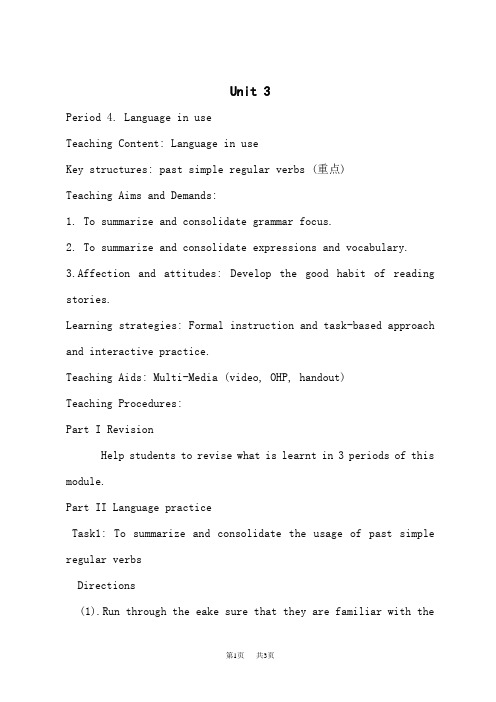
Unit 3Period 4. Language in useTeaching Content: Language in useKey structures: past simple regular verbs (重点)Teaching Aims and Demands:1. To summarize and consolidate grammar focus.2. To summarize and consolidate expressions and vocabulary.3.Affection and attitudes: Develop the good habit of reading stories.Learning strategies: Formal instruction and task-based approach and interactive practice.Teaching Aids: Multi-Media (video, OHP, handout)Teaching Procedures:Part I RevisionHelp students to revise what is learnt in 3 periods of this module.Part II Language practiceTask1: To summarize and consolidate the usage of past simple regular verbsDirections(1).Run through the eake sure that they are familiar with theuse of past simple regular verbs(2). Ask the Ss. to repeat the sentences in the boake othersimilar examples?”(4).Focus the Ss’s attention on the ways in which they are used:Task2: Complete the passage with the correct form of the words in brackets.Directions:(1). Do activity 1 on page 60.(2). Ask the Ss. to call out the answers from the whole class.(3). Ask the Ss. to read the complete sentences.(4). Then read the passage loudly.(5) Summarize: the formation of the past simpleVerbs ending in “y”lose the “y”and add –ied cry-cried hurry-hurriedVerbs ending in “e”just add –d decide-decided live-livedSome verbs need to double the consonant before adding –ed stop-stopped(1)Task 3: Complete the passage with the correct form of the wordsin the boplete the passage with the correct form of the wordsin the box.(2)Exchange work and peer correct with another pair for accuracy.(3) Call the answers back from the class.Part IV: A testDo Ex 2 on page 120 in the WB. Let’s see who can finish it as soon as possible.Part V: Homework:Finish all the exercises in the WB.。
外研版英语七年级下册:Module 8 Unit 3 Language in use 学案设计(无
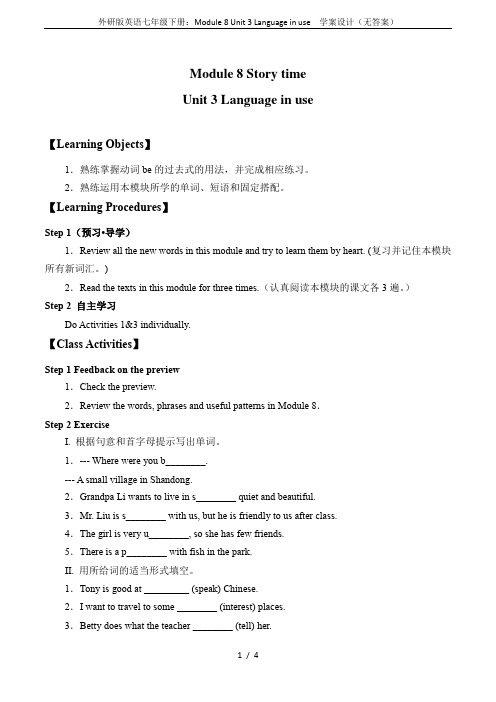
Module 8 Story timeUnit 3 Language in use【Learning Objects】1.熟练掌握动词be的过去式的用法,并完成相应练习。
2.熟练运用本模块所学的单词、短语和固定搭配。
【Learning Procedures】Step 1(预习•导学)1.Review all the new words in this module and try to learn them by heart. (复习并记住本模块所有新词汇。
)2.Read the texts in this module for three times.(认真阅读本模块的课文各3遍。
)Step 2 自主学习Do Activities 1&3 individually.【Class Activities】Step 1 Feedback on the preview1.Check the preview.2.Review the words, phrases and useful patterns in Module 8.Step 2 ExerciseI. 根据句意和首字母提示写出单词。
1.--- Where were you b________.--- A small village in Shandong.2.Grandpa Li wants to live in s________ quiet and beautiful.3.Mr. Liu is s________ with us, but he is friendly to us after class.4.The girl is very u________, so she has few friends.5.There is a p________ with fish in the park.II. 用所给词的适当形式填空。
1.Tony is good at _________ (speak) Chinese.2.I want to travel to some ________ (interest) places.3.Betty does what the teacher ________ (tell) her.4.Please listen to the teacher ________ (careful).5.The woman asks us about our ________ (life).6.What about ________ (play) the computer games? 7.Math is one of my favorite ________ (subject).8.The girl often does some ________ (shop) every Sunday. 9.It’s very important ________ (learn) English well. 10.Miss West is my ________ (two) English friend.II. 单项选择。
外研版七年级下册英语 Module 8 unit 3 Language in use导学案设计 (w
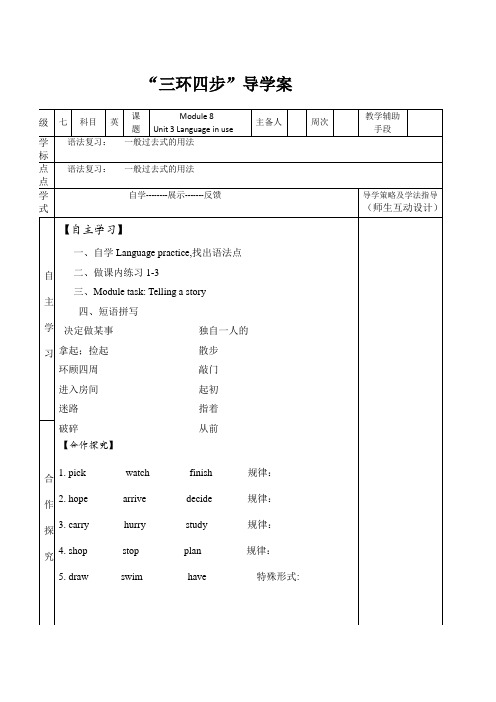
迷路__________________指着______________________
破碎_______________________从前__________________
【合作探究】
1. pick________watch________finish_______规律:______________
5.露西不喜欢香蕉,我也不喜欢。
Lucy doesn’t like the bananas, I _________ like __________.
6.当小女孩看到那只熊的时候,她急忙冲出了房子。
When the little girl saw that bear, she ______ ______ ______ the house.
2.我书包里什么也没有。_________ __________ in my bag.
3. ----你昨天给父母打电话了吗?------是的。
----_____you_____your parents yesterday? ----Yes, I ______.
4.莉莉没有说再见就离开了房间。
Lily left the house _________ saying goodbye.
年级
七
科目
英
课题
Module 8
Unit 3 Language in use
主备人
周次
教学辅助手段
导学
目标
语法复习: 一般过去式的用法
重点
难点
语法复习: 一般过去式的用法
导学
模式
自学--------展示-------反馈
- 1、下载文档前请自行甄别文档内容的完整性,平台不提供额外的编辑、内容补充、找答案等附加服务。
- 2、"仅部分预览"的文档,不可在线预览部分如存在完整性等问题,可反馈申请退款(可完整预览的文档不适用该条件!)。
- 3、如文档侵犯您的权益,请联系客服反馈,我们会尽快为您处理(人工客服工作时间:9:00-18:30)。
七年级英语主备人:审核人准印人:
Module 8 Story time (5)
Unit 3 Language in use.
日期班级姓名 _ 学号__________ 组别 _ 评价 ___ 【学习目标】
( ) 1 能掌握规则动词过去式的用法。
( ) 2. 综合运用本模块知识。
( ) 3. 利用本模块话题进行写作。
【学习过程】
( )温故知新完成句子(合上书本独立完成)(4’)
1) 用手指人是粗鲁的行为。
It’s rude to _______________________ people .
2) 他在公车上站了很久,想坐下来。
He ______________________________ because he stood on the bus for long.
3) 起床时间一到,所有学生匆忙从床上跳起来。
As soon as the bell rang , all the students ______________________ the bed in a hurry .
4) 杯子从他的手上掉下来,摔成了碎片。
The cup fell down from his hand and _______________________________ .
5) 他饿极了,没拿饭卡就飞快地冲出课室。
He was so hungry that he ______________________________ the classroom __________ the card.
自主学习:(预习导学)
()一.预习:做课本P52 A1, A2, (要求独立完成 5’)
()二.(自己或组长带领)阅读课本P53, Around the world两次翻译短文:__________________________________________________________________________________
__________________________________________________________________________________
______________________________________________________________________(交组长检查)()三. 完成《英语周报》Module8 第4版“课时学案”“随堂导练”((合上书本独立完成)(10’) ()四. 先读《英语周报》Module 8 第6版写作指导,领悟写作方法,完成《英语周报》Module 8 第6版“模块写作”(写在作业本上)
()你的疑点:__________________________________________________________________________
课堂学习
Task 1 学习小组讨论预习情况,并展示答案。
通过点评、质疑解决预习中的难题。
(13分钟)
Task 2 学习Activity 1-2 ,并在班内作大展示。
Task 3 Around the world 学习。
Task 4本模块题写作
修改完成《英语周报》Module 8 第6版“模块写作”(在作业本上)
【课堂检测】作文展示和点评
______________________________________________________________________________
【课堂小结】(5分钟)
本话题写作中要注意的问题:
_____________________________________________________________________________ _____________________________________________________________________________ _____________________________________________________________________________ 你的收获:。
